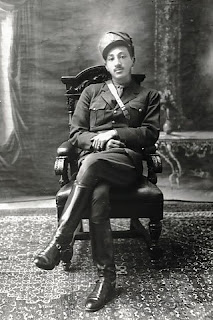The Second World War is one of the most popular periods for wargamers and those interested in history, not least because of the breadth of the conflict. It touched almost all parts of the world, and many have family members engaged in living memory. However, new areas of interest come to light despite the veritable mountain of books and other resources on the subject.
I was researching in the National Archives for my latest project when I came across a memorandum from the Secretary of State for India to the Cabinet headed, 'Question of Russian Threat to India', dated 21 September 1939. Until I read the date, I assumed this was a 19th century 'Great Game' period note misfiled!
While today we remember the Soviet Union as a crucial, if not a war-winning ally in WW2, this was not viewed that way in 1939. I highlighted one of Churchill's wilder plans to send a Royal Navy fleet into the Black Sea in a blog post last June. Churchill put a proposal to the War Cabinet in October 1939 (CAB 65 W.M. 76 (40) 27.3-40.) to insert submarines into the Black Sea to interrupt Russian oil supplies to Germany. This was in addition to the better-known plans to bomb Russian oilfields in Baku, known as the Massigli Affair. In effect, this would have been a declaration of war against the Soviet Union and fighting Germany. The Molotov–Ribbentrop Pact had also been signed just over a month before this memorandum.
The purpose of this memorandum was to advise the Cabinet of the Afghan Government's increasing apprehension of Russian aggression in the region. The Secretary of State's concern was over the inadequacy of British defences should the Russian's make a move through Afghanistan. The Indian War Plan only envisaged an incursion from the Afghan's similar to the 1919 Third Afghan War; they were not equipped to take on a first-class military power.
The Afghan army of the period was not insignificant. It had 103,000 men and had received a significant loan from the Germans to train and possibly equip a full division. The Afghan Air Force had British trained pilots flying 20 Hawker Harts and 8 Hawker Hinds. There were also a few Italian RO-37s. The Afghans had turned to the Germans because they received insufficient British security guarantees in the face of a perceived Soviet invasion threat. The Afghan royal family were pro-British, but they felt the British offer of economic help was insufficient.
 |
| King Zahir (1933-1973) (Haji Amin Qodrat, Kabul, Public domain) |
The memorandum sets out the British forces available for frontier defence. These included 11 infantry brigades and 5 artillery regiments, backed up with an immediate reserve of one cavalry brigade, 4 infantry brigades and 4 artillery regiments. Other units could be made available from internal security forces in India and the general reserve. The RAF was particularly weak, with only two bomber and four army cooperation squadrons available. The memorandum was particularly concerned about Russian air raids, given the absence of fighter squadrons and only a single AA battery.
As WW2 had opened in Poland when this memorandum was written, the Secretary of State was obviously aware that he was unlikely to receive reinforcements. He, therefore, argued for sabotage operations on Russian communications in Turkistan, by recruiting Afghans or disaffected refugees. Poor lines of communication into Afghanistan were seen as the biggest Soviet weakness in the region. The Russian Central Asia Military District (incorporated the former Turkistan MD) was home to 12 divisions during this period. Although many more could be shifted there if war broke out.
The British did little other than strengthen their intelligence operations in the region, and fortunately, nothing came of the threat, real or perceived. However, if you are looking for a new enemy for your early war Russians, try Afghanistan and British India.
 |
| 28mm Soviet infantry |
Fascinating and would provide a nice 'what if?' campaign for some future games.
ReplyDelete